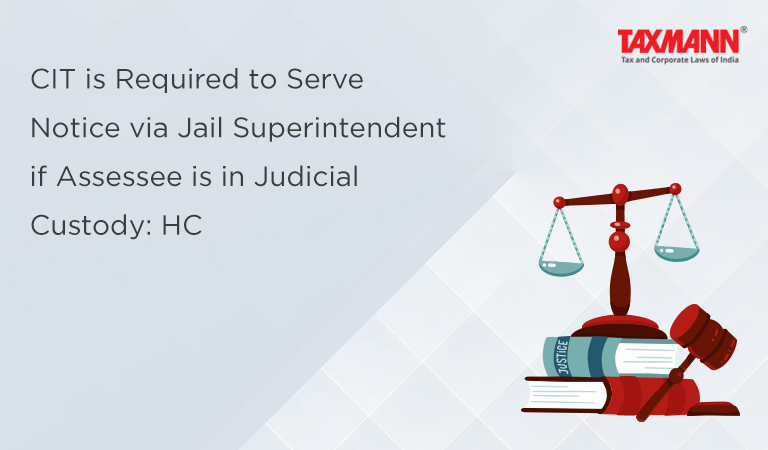CIT is Required to Serve Notice via Jail Superintendent if Assessee is in Judicial Custody: HC
- News|Blog|Income Tax|
- 2 Min Read
- By Taxmann
- |
- Last Updated on 29 April, 2023

Case Details: PCIT (Central) v. Narayan Kumar Khaitan - [2023] 149 taxmann.com 243 (Orissa)
Judiciary and Counsel Details
-
- Dr. S. Muralidhar, CJ. & M.S. Raman, J.
- Radheyshyam Chimanka, Sr. Standing Counsel & A. Kedia, Jr. Standing Counsel for the Appellant.
Facts of the Case
A search and seizure operation under section 132 was conducted on SM and group wherein certain incriminating documents were found. Subsequently, assessment in case of assessee was completed under section 153C, read with section 143(3).
The Principal Commissioner invoked revisionary jurisdiction under section 263 against said assessment order and subsequently issued a notice for being served upon assessee at his last known address. In reply, a staff member of assessee appeared and informed that assessee was in judicial custody. The Principal Commissioner treated the staff member’s appearance as sufficient in terms of section 292BB and passed the order under section 263.
On appeal, the ITAT granted relief to the assessee. Aggrieved-CIT filed the instant appeal before the Orissa High Court.
High Court Held
The High Court concurs with the observation of the ITAT in the impugned order that a person in judicial custody is deprived of many of the constitutional rights which he could otherwise exercise.
Any officer of the Government, including a PCIT, should be conscious that once information was received that a person to whom notice has to be served is in judicial custody, an appropriate order should be passed requiring service of notice on such person through the Superintendent of the concerned jail. This is the bare minimum requirement in law.
With the PCIT having failed to do so, it was not open to the Department to contend the mere appearance of a staff of such person in judicial custody before the PCIT should be taken to be the appearance by the Notice/Assessee himself.
Accordingly, service of notice to staff member could not be assumed to be valid and thus, the impugned order passed under section 263 was liable to be quashed.
List of Cases Reviewed
-
- Narayan Kumar Khaitan [IT Appeal Nos. 170 to 175 (CTK) of 2019, dated 15-6-2022] (para 11) affirmed.
- CIT v. Privilege Investment (P.) Ltd. [2017] 88 taxmann.com 559/395 ITR 147 (All.) (para 11)
- CIT v. Madhsy Films (P.) Ltd. [2008] 175 Taxman 347/301 ITR 69 (Delhi) (para 10) followed.
List of Cases Referred to
-
- CIT v. Madhsy Films (P.) Ltd. [2008] 175 Taxman 347/301 ITR 69 (Delhi) (para 10)
- CIT v. Privilege Investment (P.) Ltd. [2017] 88 taxmann.com 559/395 ITR 147 (All.) (para 11).
Disclaimer: The content/information published on the website is only for general information of the user and shall not be construed as legal advice. While the Taxmann has exercised reasonable efforts to ensure the veracity of information/content published, Taxmann shall be under no liability in any manner whatsoever for incorrect information, if any.

Taxmann Publications has a dedicated in-house Research & Editorial Team. This team consists of a team of Chartered Accountants, Company Secretaries, and Lawyers. This team works under the guidance and supervision of editor-in-chief Mr Rakesh Bhargava.
The Research and Editorial Team is responsible for developing reliable and accurate content for the readers. The team follows the six-sigma approach to achieve the benchmark of zero error in its publications and research platforms. The team ensures that the following publication guidelines are thoroughly followed while developing the content:
- The statutory material is obtained only from the authorized and reliable sources
- All the latest developments in the judicial and legislative fields are covered
- Prepare the analytical write-ups on current, controversial, and important issues to help the readers to understand the concept and its implications
- Every content published by Taxmann is complete, accurate and lucid
- All evidence-based statements are supported with proper reference to Section, Circular No., Notification No. or citations
- The golden rules of grammar, style and consistency are thoroughly followed
- Font and size that’s easy to read and remain consistent across all imprint and digital publications are applied




